#Golden Rocket
Text

1956 Oldsmobile Golden Rocket
Bullet on Wheels: The 1956 Oldsmobile Golden Rocket
Easily one of the wildest General Motors dream cars of the Motorama era, the Olds Golden Rocket was the epitome of Jet Age design. Let’s take a closer look.
Throughout the 1950s, Harley Earl and his forward-looking crew at the GM styling studios frequently turned to aircraft and space travel for their inspiration. There might be no better example of the automaker’s guided-missile design theme than the far-out Golden Rocket, Oldsmobile’s Motorama dream car for 1956. “The Supersonic Age comes to automobile styling!” the company proclaimed.

1956 Oldsmobile Golden Rocket
Constructed in fiberglass on a shortened Oldsmobile passenger car perimeter frame with a 105-inch wheelbase, the Golden Rocket was essentially a bullet on wheels in side view (above.) But under the skin, the show car was fairly conventional with a 324 CID, 275-horsepower Olds Rocket V8 up front, Hydra-Matic automatic transmission, and leaf-spring rear suspension. The custom wheels employed integral brake drums, and a pair of fuel tanks were housed in the rear fenders. Note the “dotted-line” segmented whitewalls, a novel feature that never went any further.
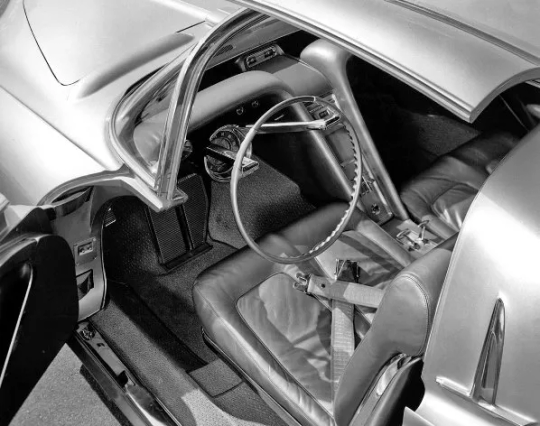
1956 Oldsmobile Golden Rocket
At a little more than 200 inches long but less than 50 inches tall, the Rocket sported an impressively low silhouette, which required some ingenuity in the packaging of the two-seat cabin. For easier entry and egress, a roof panel popped up when the door was opened on either side, while the steering wheel rim swung upward and the bucket seats rose three inches and pivoted on their mountings. Upholstery was blue and gold leather, while the speedometer was housed in the steering wheel hub. The lap belts and driver pedals display a strong aircraft influence.
While the Rocket seems to be one of the more obscure GM dream cars in current times, it did include some ideas that turned up later on the General’s production models. The stubby rocket-type tailfins would adorn some memorable Cadillacs of the early ’60s, while the split-window teardrop rear window is extremely familiar. It was next tried on a dead-ended 1958 Corvette styling proposal, then famously appeared on the 1963 Corvette Sting Ray coupe. As with a number of GM Motorama dream cars, the fate of the Golden Rocket was not officially documented, reportedly, but it hasn’t been seen or heard from in years and is presumed destroyed.

1956 Oldsmobile Golden Rocket
93 notes
·
View notes
Photo
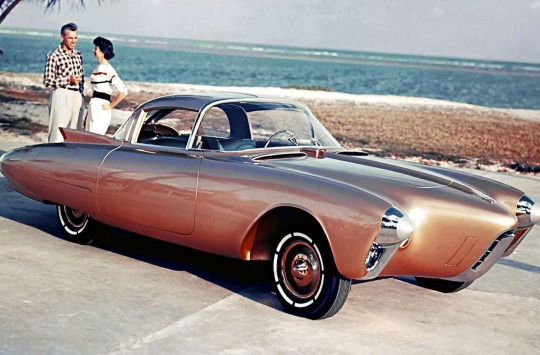
288 notes
·
View notes
Text
youtube
This is fantastic!! Looking forward to the day we'll have a Blake & Mortimer film.
#come on!!#Blake et Mortimer#Blake and Mortimer#le secret de l'espadon#L'Aile Rouge#L'Espadon#Golden Rocket#Youtube
13 notes
·
View notes
Text

golden child
860 notes
·
View notes
Text
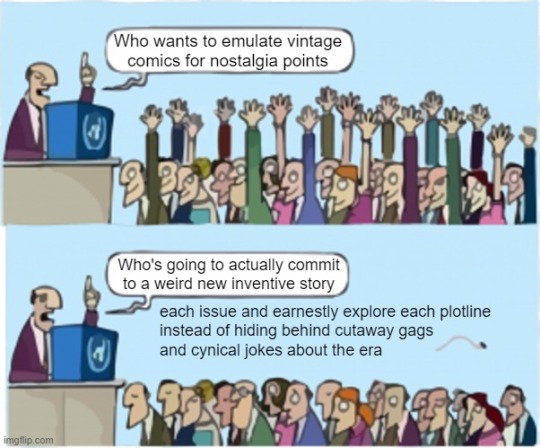
#I hate when something trying to be golden age style uses a campy plot idea for a single cutaway panel#and then goes ''well that just happened''#Do you think I come to vintage comics just for the aesthetics of american exceptionalism?#No I want to know step by step how you defeated the intelligent dinosaur with a rocket launcher using your fists and your wits. Go on.#comics
546 notes
·
View notes
Text
groot adopts rocket, rocket adopts groot, groot adopts adam, rocket adopts adam
#a family of a tree a raccoon and a golden himbo can be so personal#adam warlock#rocket raccoon#groot#gotg3#gotg3 spoilers#guardians of the galaxy#guardians of the galaxy 3 spoilers#gotg vol3 spoilers
506 notes
·
View notes
Text
#talkin#tik tok#nba#stephen curry#steph curry#dillon brooks#basketball#golden state warriors#houston rockets#national basketball association
107 notes
·
View notes
Text
WARRIORS WON A GAME 😭

Steph had 32, embarrassed Brooks again and locked him up on defense multiple times ‼️

And Klay finally scored 20 points!!!!!!
#Steph curry hates the Houston rockets#steph curry#stephen curry#golden state warriors#klay thompson
32 notes
·
View notes
Text
i’m bored and have the poll creating ability, so
#dsmp#polls#mcyt#dream smp#dsmp poll#crime boys#bedrock bros#rivals duo#bee duo#clingy duo#tnt duo#rocket duo#disc duo#twins duo#golden duo#obviously there are more#but i’m curious#so#please vote#poll
112 notes
·
View notes
Text
This is my best attempt at drawing Rocket and Sun as dogs :3

Rocket is @ramblingsofacotlfangirl’s oc

Is it just me or does Sun gives of a bit of golden retriever energy?
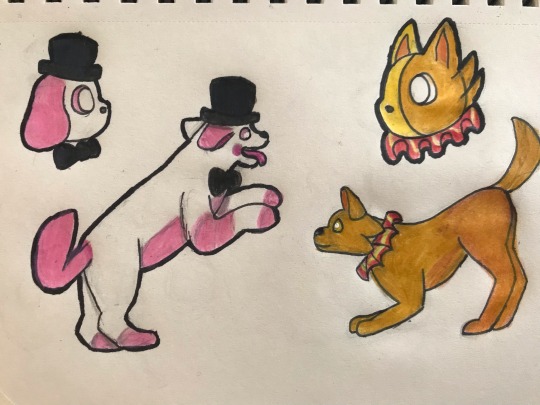
I have a long way before being able to draw dogs properly :p
#five nights at freddy's#fnaf#doodle#daily doodle#fnaf sb#fnaf daycare attendant#fnaf sun#fnaf rocket#not my oc#dog#:3#five nights at freddy’s security breach#golden retriever
15 notes
·
View notes
Text
that being said please talk to me about shared lore i will be so happy and excited to talk about it and won't shut up (promise AND a threat)
16 notes
·
View notes
Text

The Oldsmobile Golden Rocket
The Oldsmobile Golden Rocket was a two-seater show car built by Oldsmobile for the 1956 General Motors Motorama. The radically styled fiberglass concept, designed to resemble a rocket on wheels, was revised several times and displayed at various other auto shows, most notably at the 1957 Paris Motor Show where it generated much fanfare, 18 months after it was first revealed. The car was featured in the promotional short film Design for Dreaming along with the rest of the 1956 General Motors lineup.
Exterior
Similar to other Space Age show cars, the Golden Rocket was heavily influenced by the themes of aviation and space exploration. Its sleek, aerodynamic body was made entirely of lightweight fiberglass and finished in metallic bronze paint. Bullet-shaped chrome pieces resembling Dagmar bumpers were integrated into the front fenders in place of headlights as well as the sweeping rear fenders, giving the car an overall rocket-like appearance. Other notable features include a swept-back wrap-around windshield, which had already become a common design element by the mid-1950s, less prominent tailfins by contemporary standards and a split-window fastback roof design presaging the 1963 Chevrolet Corvette Stingray. It rode on unique "dotted-line" whitewall tires. A later photo taken inside the GM Design Center in Warren, Michigan shows the car sporting a blue paint scheme.
Interior
The leather upholstery was finished in blue and gold. When a door was opened, the two-piece roof panel rose automatically in a similar manner to the Mercedes-Benz 300 SL's gull-wing doors. The seats were raised up by three inches and swiveled outwards by 45 degrees, enabling easier access to the passenger compartment. One of its most pioneering innovations was the button-controlled tilt steering wheel, making it one of the first vehicles with such a feature. The speedometer was placed at the center of the foldable two-spoke steering wheel. The futuristic center console and control levers were inspired by an aircraft cockpit.
Powertrain
The car was powered by an upgraded 324-cubic inch Rocket V8 engine tuned to produce 275 horsepower (205 kW). According to interior photos, the Golden Rocket had an automatic transmission like all other Motorama show cars. Details on other internal components, however, are unavailable.
Design legacy
An early styling mock-up of the 1958 Chevrolet Corvette, built around 1956, depicted a fixed-roof fastback coupe with a rear design taken almost directly from the Golden Rocket show car, right down to the torpedo-shaped rear fenders and subtle tail fins. However, this design proposal never reached beyond the clay model stage and a more conventional design was used on the production model instead.
Seven years later, under the direction of General Motors head of design Bill Mitchell, the split rear window design would reappear on the 1963 Corvette Stingray coupe. It lasted for one model year before being changed to a single-piece rear window due to a problem of poor rear visibility.
Current status
It is unclear if the Golden Rocket still exists today. A common practice of General Motors in the 1950s was to destroy show cars after they fell out of usage in order to avoid liability concerns; however, the Golden Rocket is still unaccounted for with no confirmation it was crushed. There is photographic evidence that the car still existed as late as 1962, while several other show cars were scrapped earlier in 1959. The car was reportedly located somewhere in New Jersey, however the rumor still remains unconfirmed even after extensive investigation. Motorama historian David W. Temple believes that the Golden Rocket, along with other lost show cars, will likely never resurface again.
77 notes
·
View notes
Text
The Rocket

pdsh.fandom.com/wiki/Rocket
Creator(s): Lin Streeter
Alias(es): Unknown
1st Issue w/Uniform: Pep Comics #2
Year/Month of Publication: 1940/02



15 notes
·
View notes
Photo








TOP TRACKS OF FIRST HALF OF 2022 (SPECIAL EDITION)
hey everybody! I was tagged by @chamhwis @tomoonagenda @motodaka @exit127 @coupsnim and @suengwoo for my top tracks of january thru june of this year.
i kind of cheated, since i was not a huge fan of most of the title tracks... so! i made these only releases that ARENT regular, promoted title tracks -- this includes japanese releases, english singles & versions, and b-sides!
gifs were too much work, especially since most of these don’t have videos attached... and i wanted something done quickly, so here’s this. however it does have my patented rainbow scheme!
as for tagging... i know most if not everyone has done this, so ill be tagging specific people just because i want them to see this and validate my music taste hehe <3
@pinkhyojin @seohopeful @beomsdaisies @bangjaemin @machikeita @zigzagglitch @hoshranghaes @dokyeomblr @suyunsgf
#multi#kflops#ultkpop#op#bg#rs#tagged#pentagon#woozi#txt#tan#woodz#jamie#rocket punch#onlyoneof#treasure#yena#golden child#purple kiss#wei#jackson#pixy#mp
150 notes
·
View notes
Text

Chuck Nevitt (7’5) and Manute Bol (7’7)
52 notes
·
View notes
Text

I got this ask on main but thought I'd pick it up here, my comics history/fashion ramble blog. I'd been wondering this exact same thing recently, and Google initially wasn't much help—Rocketeer replica jackets describe themselves only as "Rocketeer jackets" and the one Lobster Johnson cosplay thread just suggested ordering one of those.

The most curious part is the double seam and horizonal row of buttons that mark out the entire front as possibly being an unbuttonable "bib", like a plastron front. (Please don't ask how late in the game I worked out that "plastron" is the right word for that.)
The closest genuine Golden Age example of a plastron jacket I found was the military tunic style uniform of Blackhawk, created in 1941.

(Pics from the '52 movie serial (right) really show how awkward it is to combine open lapels + plastron. On a double breasted coat, that chest panel IS the bottom lapel, folded shut.)
Here's the thing: This outfit mirrors that of the Nazi ace pilot he fights in the origin issue, von Tepp (middle). And compare further to the far right: real life WWI flying ace Manfred von Richthofen, AKA the Red Baron, in imperial German Uhlan (lance cavalry) uniform.

"The Germans had designed such great costumes, we decided to use them ourselves," co-creator Cuidera is quoted as saying in Steranko's History of Comics, which (more dubiously, in my opinion) compares the look to the Gestapo or SS. Breeches or jodhpurs weren't strictly a Nazi thing at the time, but they do add to the overall effect.
Compare two other military tunic themed costumes from 1940, on Captain Marvel and Bucky Barnes. These are asymmetrically buttoned, and switch to a more classic circus strongman look below the waist.

But somewhere around 1975, with the Invaders book, Bucky gets a buttoned bib! There's something infectious about it—the symmetry, maybe. (Even re: the characters we started with; Mignola didn't draw Lobster Johnson with buttons down the right side, but every artist after does. And Spider-Noir wore a sweater under his coat until Shattered Dimensions introduced the double-breasted vest.)
If it didn't reach his belt, Barnes' button-on front + shirt collar combo would resemble a bib-front western shirt, like the one that became the Rawhide Kid's signature look in '56. (Or Texas Twister's in '76.)
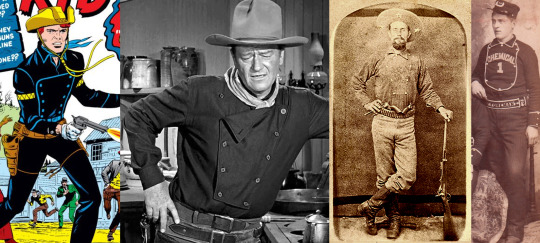
This shirt entered the old-West-obsessed public imagination in the 1940s/50s largely because John Wayne wore it in several cowboy movies. In reality it was rare among cowboys, more common with firefighters and civil war era militia.
Military tunics, Western shirts, alright, but does anything match the style and material and era, or are these jackets a total anachronism? I tried looking into 1930s leather flight jackets and was surprised when the closest-looking results were marked as Luftwaffe.
It took me a bit to work out why: USAF and RAF issued standard flight jackets with a center closure. The Luftwaffe instead let their pilots buy non-standardized ones. The 'weird' double-breasted black German flight jackets were in fact fairly normal (but repurposed) motorcycle racing jackets.
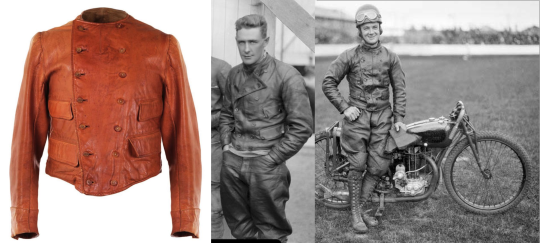
Far left is an English biker's jacket that dates back to the 1920s. Even without the bib, this may be as close as you'll get to an authentic Rocketeer. The jodhpurs were pretty common to complete the look. (What was an early motorcycle anyways, if not a weird metal horse?) The first biker jacket with the now iconic off-center diagonal zip was designed in America in 1928 and yet as far as I can tell, not a single actual pre-war pulp hero wore one.
The greatest weakness of this post is that I haven't been able to find any of these artists' notes on how, exactly, they arrived at similar versions of this iconic Pulp Front Panel Jacket. I'm sure I've missed some things. But as far as I can tell, this jacket is an odd bit of convergent stylistic evolution from the above influences that's picked up enough momentum to now be self-perpetuating.
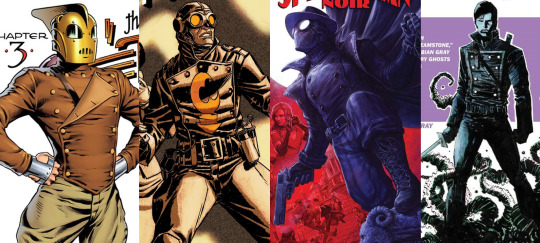
The problem with pulp heroes is that for the most part, they just wore clothes. The appeal of this jacket is actually very similar to what the 1940s thought the appeal of the bib-front shirt in westerns was: It's alien enough to feel "old". It looks like something invented before zippers or synthetic fabrics. It looks formal and militant but also renegade, rebellious. It also looks a little mad-sciencey*. It's a costume, but you can nearly fool yourself into thinking the past was weird enough that you could find something this cool on the rack.
If I wanted to end on some grand point, I could try to argue that there's a thematic throughline between fascist fashion, John Wayne movies, and throwback pulp. A manufactured aesthetic valorizing the violence of a fictional golden age... but I think the noir stylings of the post-Rocketeer comics in this lineup mean that, at least on some level, they know the "good guys" didn't dress like this.
*If I had another couple weeks of time to burn, I'd try to trace the visual history of the Howie coat in popular culture and investigate its possible connections to this. Alas, I do actually have a life.
#thank you for reading. also don't read golden age blackhawks the racism is awful even by era standards.#comics history#costume taxonomy#<- forgot I had that tag.#not to be like ''in MY favorite comics...'' again but may I point out that Hellboy and Robo and Tom Strong just wear... clothes#like. yknow. A pulp series that had confidence in itself rather than trying to cosplay as eras it thinks were cooler might do-#[I am yanked offstage before I can restart that rant]#the rocketeer
119 notes
·
View notes